Bald Eagles of Broward County, Florida
› ARCHIVED Pembroke Pines OBSERVATIONS & PHOTOS FROM PRIOR NESTING SEASONS
›
ARCHIVED 2012-2013 NESTING SEASON OBSERVATIONS AND PHOTOS
BLOG: Pelicans and spoonbills in the lake southeast of eagle nest
BLOG: Pelicans and spoonbills in the lake southeast of eagle nest
|
Administrator
|
On Saturday morning, November 24 we departed Chicago Midway Airport where the temperature was 20 degrees (F), and at noon we were treated to a balmy 74 degrees at Fort Lauderdale Airport. Put away the fleece and back into T-shirts and shorts! Now is when I love living in Florida! South Florida enjoys two seasons: Hot and wet from June through September, and mild and dry from October through May. We had departed for our second home in Illinois in late October, after a period of abnormally abundant precipitation. Our lake was filled to brimming. Birding had been slow in our local birding patch next to our subdivision because because fish and other aquatic prey were diluted in the high water, dispersing the long-legged waders throughout the Everglades. Hurricane Sandy brushed by just after we departed Florida, delivering high winds and beach erosion but little moisture. After that, temperatures moderated and rainfall was scant. Our lake has receded about two feet since our trip north, and now its margin no longer reaches up to cover part of our back lawn.  We slept with open windows, and early the next morning wasted no time getting back out on the gravel road that extends a mile from the entrance of our subdivision into the water conservation area. As usual, we started out walking briskly, Mary Lou in the lead, while I lugged my binoculars and camera gear a few paces behind her. She pointed out a nice Northern Cardinal along the path. Of course I stopped to take his picture, then struggled to keep up, feeling like a toy poodle on a jogger's leash. 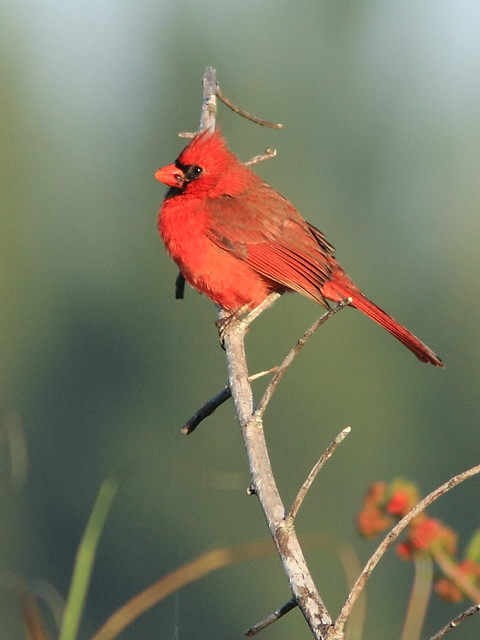 Ahead, we beheld an unusual and welcome sight as we approached the Harbour Lakes mitigation impoundment (a fancy name for land set aside by the developer to compensate, rather symbolically, for the damage caused by draining and filling the historic Everglades to build our homes). The white forms of scores of ibises, egrets and (Holy Cow!) American White Pelicans circled over the lake. 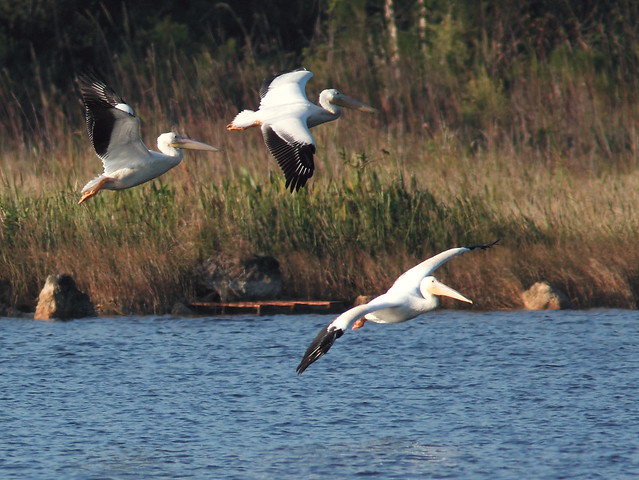 Since moving here in 2004, despite our nearly daily walks, we had never encountered pelicans on our birding patch. The pelicans fed cooperatively, driving a school of fish in front of them as they advanced in a line. Lower lake levels had concentrated their prey into a nutritious "soup." 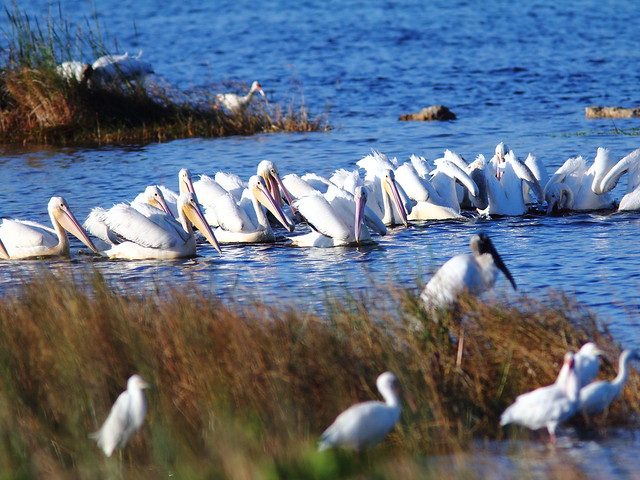 I counted 23 pelicans. They approached closely, following the frightened fish up to the shoreline. 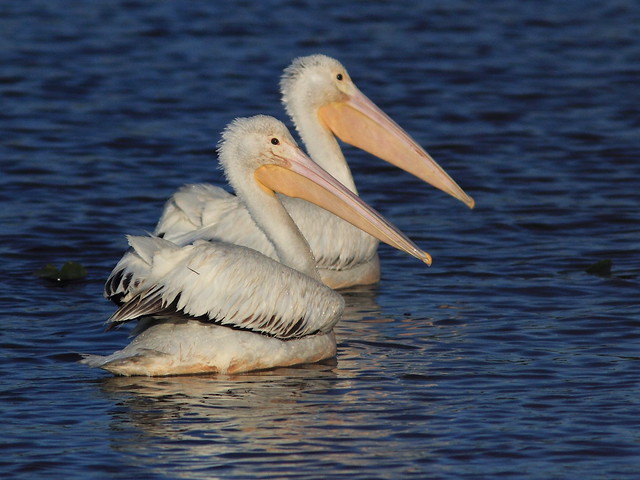 This brief film clip demonstrates the pelicans' cooperative fishing technique (I didn't realize that I still have a New Jersey accent after being away 50 years!) [Trouble viewing? Go to VIMEO at this link] Masters of flight, some of the pelicans wheeled overhead. 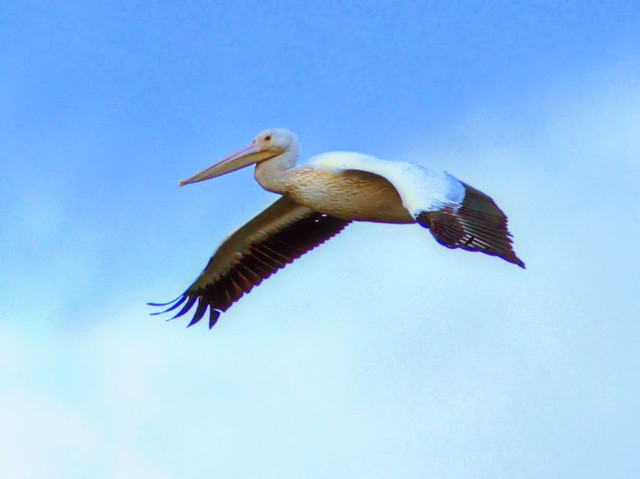 Wood Storks joined them. 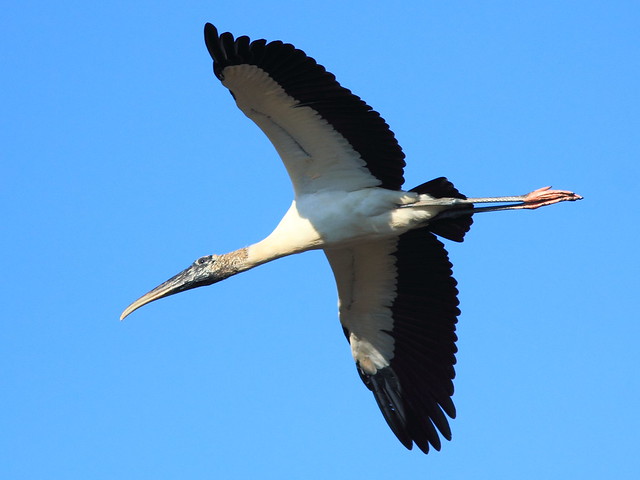 By now I had fallen far behind Mary Lou. I barely heard her shout: "Spoonbills!" Yes! Three Roseate Spoonbills dabbled with the storks, ibises and egrets, up close and personal. (Two days later on November 27, a fourth spoonbill was present).  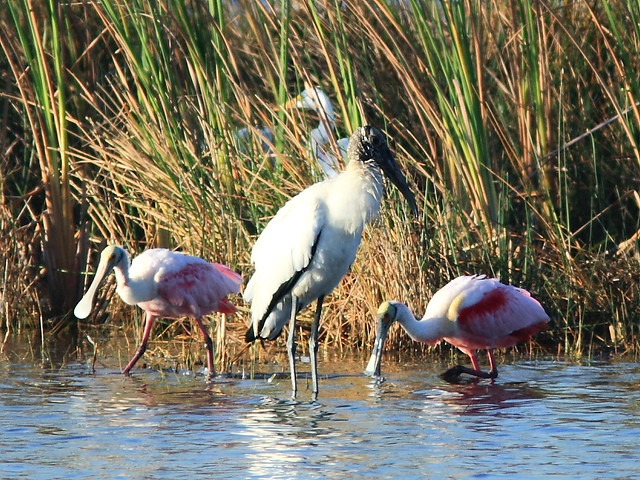  This video clip shows the spoonbills' feeding technique. [Trouble viewing? Go to VIMEO at this link] A Great Egret flew in to join an immature Great Blue Heron (note its darker plumage and black cap) that was feeding with the spoonbills and pelicans. 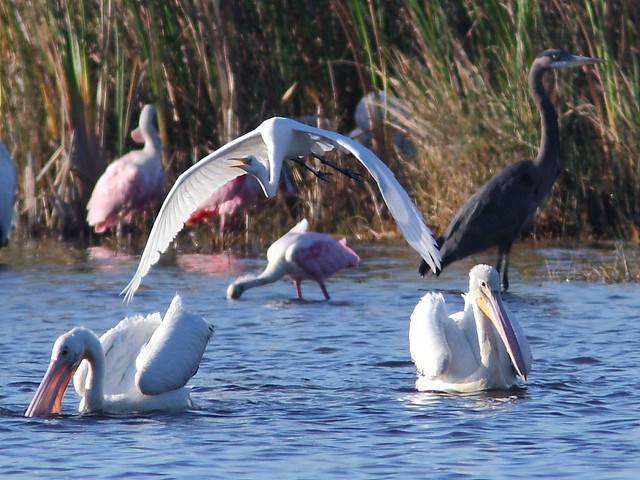 Like storks, spoonbills are tactile feeders-- they sweep their specialized bills and clamp down when they detect their prey, which consist mostly of fishes and other aquatic animals. The water is just the right depth to keep their eyes from being submerged. This immature Little Blue Heron is a sight feeder. It adapts the typical posture of its species while stalking for fishes, the tip of its bill just above the surface of the water. 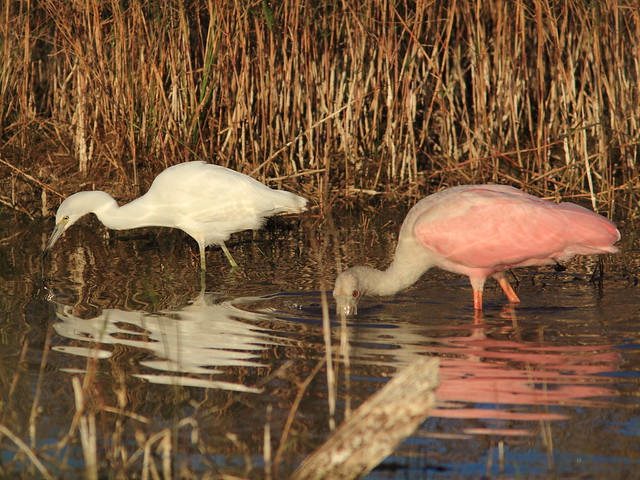 The waders included several adult Little Blue Herons... 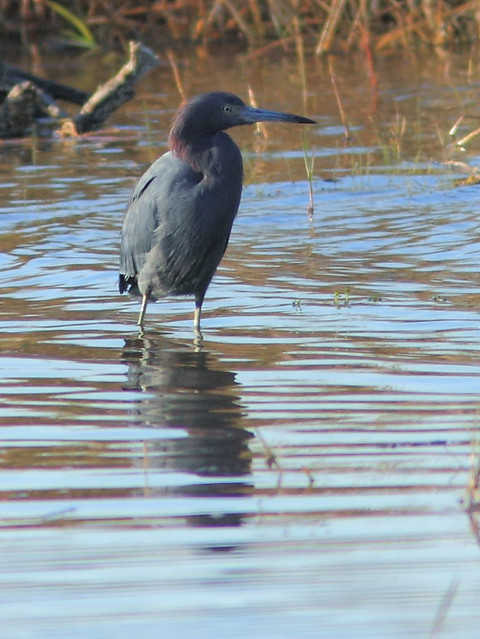 ...and Snowy Egrets. 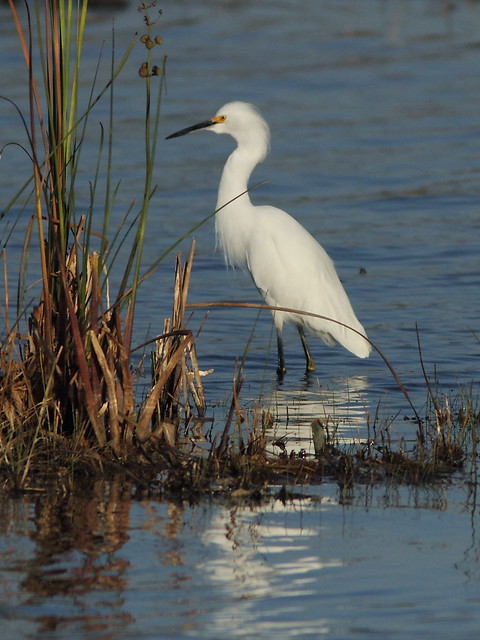 In this interesting shot, both a spoonbill and a pelican are demonstrating how they use their bills as strainers. 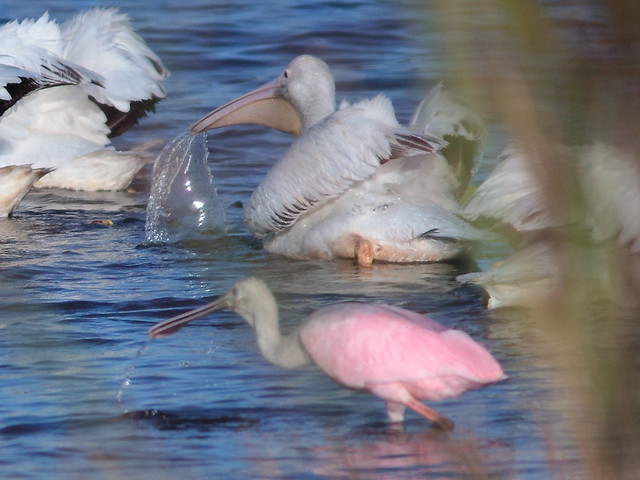 A Bald Eagle flew over and at least a hundred egrets, herons, ibises and spoonbills took flight. The pelicans seemed not to be disturbed by the predator. 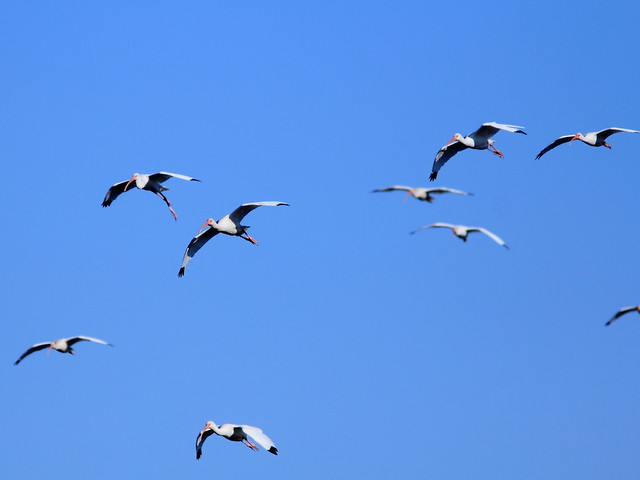 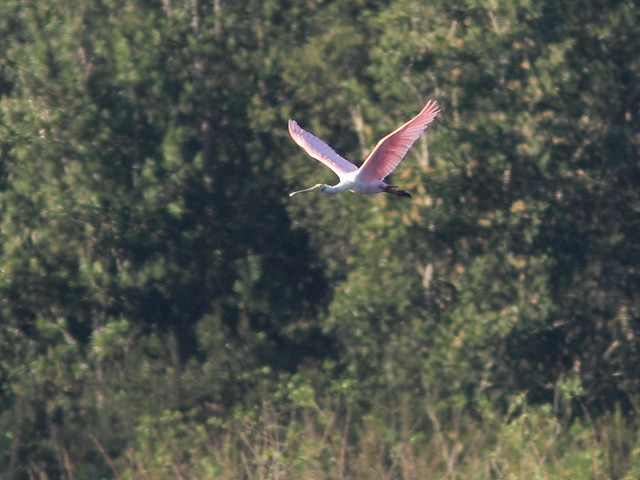 Three drab Double-crested Cormorants watched a colorful spoonbill fly by. I call this photo "feather envy." 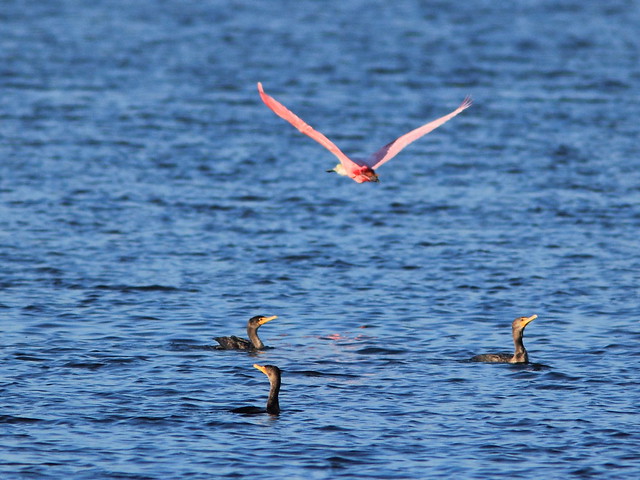 We logged 45 bird species, among them a Caspian Tern... 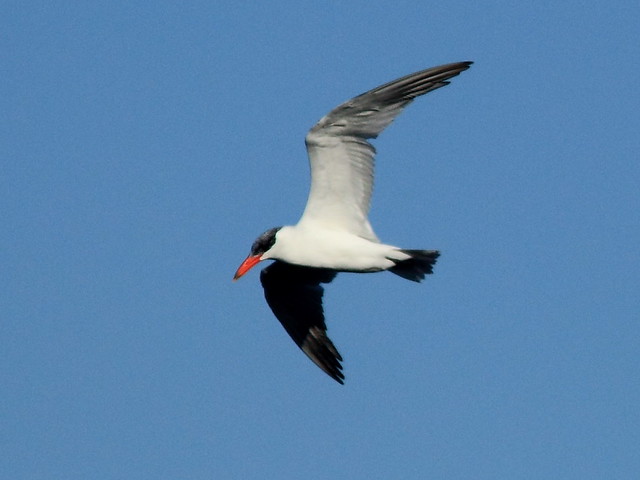 ...a lone Mottled Duck... 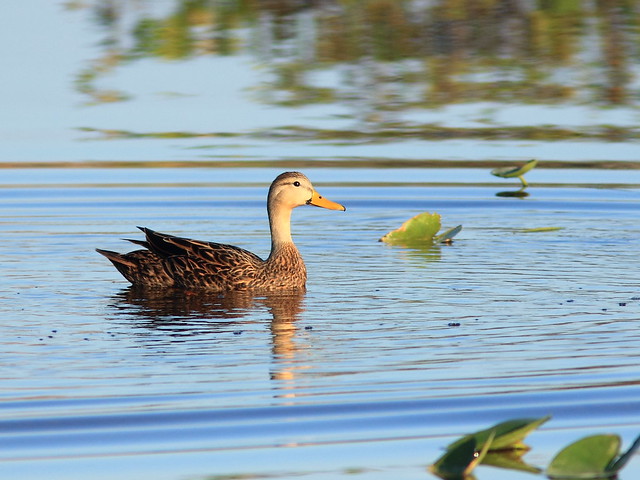 ...a belted Kingfisher... 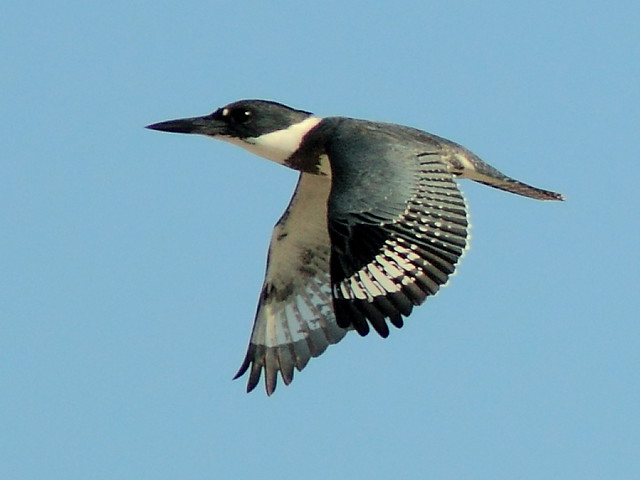 ...and four distant Red-breasted Mergansers. 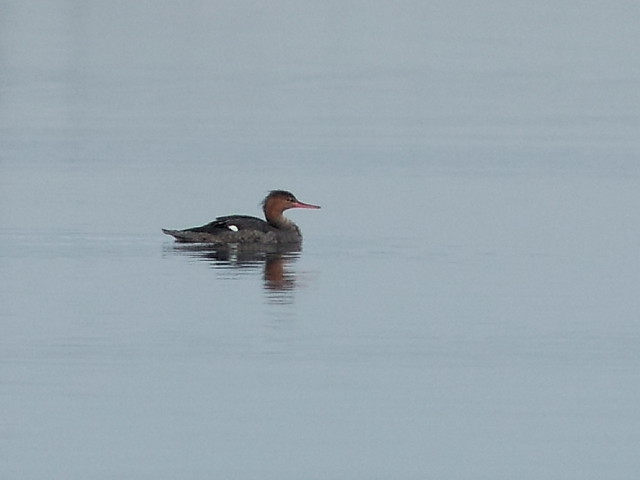 On our second walk, clouds gathered over the impoundment. Note the grove of exotic Melaleuca trees to the right. They were treated with herbicide a couple of months ago. Two years ago, a pair of Ospreys nested there. Soon they will be cleared to make way for the highway extension that will also result in the paving of our beloved gravel road. Progress!  Our walk was cut short by a rain storm that came up suddenly. This is the view in front of me as we hurried home. The shower lasted only a few minutes. 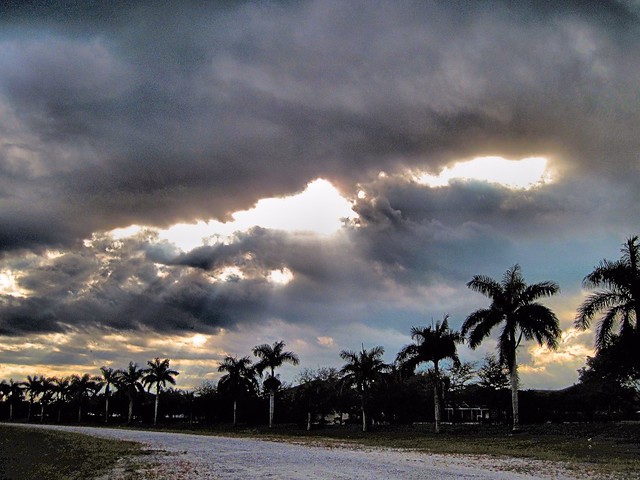
Ken Schneider
Web site: http://rosyfinch.com Blog: http://rosy-finch.blogspot.com Photos: <http://flickr.com/photos/rosyfinch> |
|
WOW, Ken!
What fantastic photos and videos! Wish I had someplace like your lake to walk to see all those beautiful birds. I have to drive many miles to see something like that. Thank you for sharing. Jill |
Re: BLOG: Pelicans and spoonbills in the lake southeast of eagle nest
|
In reply to this post by NewMexiKen
Hello. A returning lurker . . ..
I saw your blog, comments and replies about wood storks. I drive along Stirling through the Sunshine Ranches area of SW Ranches (between Volunteer and Flamingo) almost daily and over the past year or so I have seen wood storks on several occasions standing next to or wading in the shallow canals, either the one right along Stirling or one of the ones that runs off of the one along Stirling. I don't think I have ever seen more than one at a time, there might have been 2 once, but I could be seeing hte same lonely bird each time. I do not ever remember seeing any before about a year ago, although I am certainly not looking hard as I'm driving in the morning and I don't stay and observe them, but maybe there is a colony close by . . . I believe Flamingo Gardens tries to release the offspring of the injured birds who are residents there, maybe the storks I have seen are the offspring of those birds and have stayed close by. I have also caught glances of several heron species, and last fall I saw 2 pileated woodpeckers on the same tree as I was driving north along Volunteer between Sheridan and Stirling. I wish there was a way to take pictures while driving . . . |
|
In reply to this post by Jill W
I would say the birds were out in force to welcome you all back to south Florida! It's great to have you back, Ken! Beautiful images of an astonishing assortment of birds so near your home.....what a great place to walk. The information you provide, along with such beautiful photography and video is greatly appreciated....so much to learn.
|
Re: BLOG: Pelicans and spoonbills in the lake southeast of eagle nest
|
In reply to this post by NewMexiKen
Ken what type of lens are you using. I have an f4.5 600mm Olympus and I can never get that clear of shots
|
Re: BLOG: Pelicans and spoonbills in the lake southeast of eagle nest
|
Administrator
|
Thank you, Richard,
My gear (420 mm f/5.6 lens system): Canon EOS 60D 18 MP Digital SLR Camera Canon EF 300mm f/4L IS USM Telephoto Lens Canon EF 1.4X II Extender Processed with Canon DPP program that came with the camera. I shot the videos with the same camera and processed them with Windows Live Movie Maker. I should add that the landscape shots are taken with a little point-and-shoot Canon PowerShot A 1100 IS. I processed the skies in Corel Paintshop PRO 4x
Ken Schneider
Web site: http://rosyfinch.com Blog: http://rosy-finch.blogspot.com Photos: <http://flickr.com/photos/rosyfinch> |
Re: BLOG: Pelicans and spoonbills in the lake southeast of eagle nest
|
So cool to see those White Pelicans!!!! And your video showing their "round-up" fishing technique was perfect!
Unbelievable to see those pelicans there and then to have the spoonbills there too at the same time - most people would have to go to the zoo to see a grouping like that (LOL)! Keep up the great work, Ken. MF |
«
Return to ARCHIVED 2012-2013 NESTING SEASON OBSERVATIONS AND PHOTOS
|
1 view|%1 views
| Free forum by Nabble | Edit this page |

